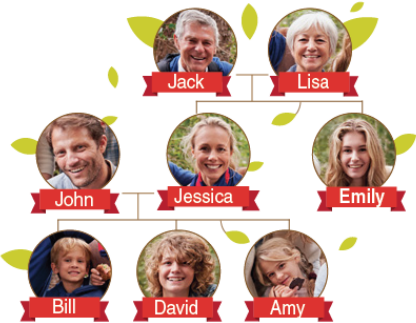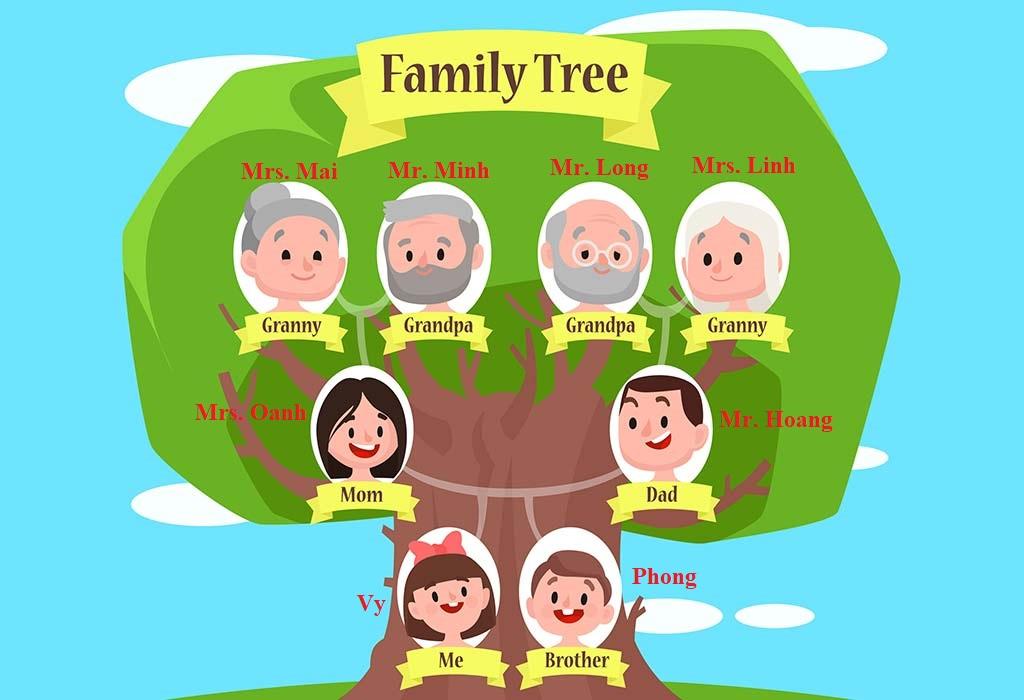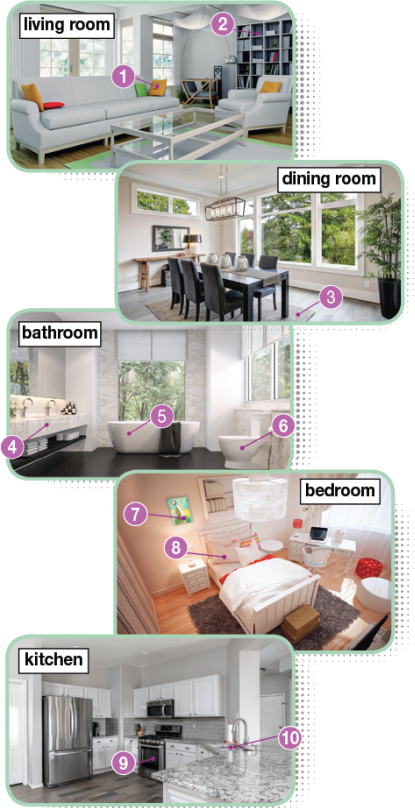Tiếng Anh 10 Bright Hello! trang 8, 9
1. Look at Emily’s family tree and underline the correct option. Then listen and check. 2. Complete the pairs with words from Exercise 1.3. Draw your family tree and present it to the class. 4. Match the numbers (1-10) in the pictures with the words below. Then listen and check. 5. Which of the things in Exercise 4 have you got in your house? 6. Fill in each gap with am, is, are, ’m not, isn’t or aren’t. 7. Ask and answer questions as in the example. 8. Look at the table and fill in each gap wit
Bài 1
Vocabulary (Từ vựng)
Family (Gia đình)
1. Look at Emily’s family tree and underline the correct option. Then listen and check.
(Nhìn vào cái cây của gia đình Emily và gạch chân phương án chính xác. Sau đó nghe và kiểm tra.)

1. Jack is Lisa’s husband/brother.
2. Lisa is Jack’s grandmother/wife.
3. Jack and Lisa are Amy’s parents/grandparents.
4. Jessica is Emily’s mother/sister.
5. Emily is Jack’s daughter/granddaughter.
6. John is David’s grandfather/father.
7. David is Jack’s nephew/grandson.
8. Bill is Jessica’s uncle/son.
9. Bill is Amy’s cousin/sibling.
10. David is Emily’s nephew/ brother.
Phương pháp giải:
husband: chồng
wife: vợ
parents: cha mẹ
grandparents: ông bà (nội/ ngoại)
grandmother: bà (nội/ ngoại)
grandfather: ông (nội/ ngoại)
sister: chị / em gái
brother: anh / em trai
daughter: con gái ruột
niece: cháu gái (của bác/ cô/ chú)
nephew: cháu trai (của bác/ cô/ chú)
grandson: cháu trai (của ông/ bà)
uncle: cậu, chú, bác trai
aunt: dì, cô, mợ, bác gái
son: con trai
sibling: anh/ chị /em ruột
cousin: anh/ chị /em họ
Lời giải chi tiết:
1. Jack is Lisa’s husband.
(Jack là chồng của Lisa.)
2. Lisa is Jack’s wife.
(Lisa là vợ của Jack.)
3. Jack and Lisa are Amy’s grandparents.
(Jack và Lisa là ông bà của Amy.)
4. Jessica is Emily’s sister.
(Jessica là chị của Emily.)
5. Emily is Jack’s daughter.
(Emily là cháu gái của Jack.)
6. John is David’s father.
(John là bố của David.)
7. David is Jack’s grandson.
(David là cháu trai của Jack.)
8. Bill is Jessica’s son.
(Bill là con trai của Jessica.)
9. Bill is Amy’s sibling.
(Bill là anh/ em ruột của Amy.)
10. David is Emily’s nephew.
(David là cháu trai của Emily.)
Bài 2
2. Complete the pairs with words from Exercise 1.
(Hoàn thành các cặp từ có trong bài tập 1.)
1. grandfather – grandmother
2. mother –
3. husband –
4. son –
5. brother –
6. aunt –
7. niece –
8. grandson –
Phương pháp giải:
Phân biệt sự khác nhau giữa niece/nephew và granddaughter/grandson
|
Đối với cô, dì, chú, bác… |
Đối với ông bà |
|
cháu gái: niece cháu trai: nephew |
cháu gái: granddaughter cháu trai: grandson |
Lời giải chi tiết:
1. grandfather – grandmother
(ông – bà)
2. mother – father
(mẹ – bố)
3. husband – wife
(chồng – vợ)
4. son – daughter
(con trai – con gái)
5. brother – sister
(anh em – chị em)
6. aunt – uncle
(dì – cậu)
7. niece – nephew
(cháu gái – cháu trai)
8. grandson – granddaughter
(cháu trai – cháu gái)
Bài 3
3. Draw your family tree and present it to the class.
(Vẽ cái cây về gia đình bạn và trình bày nó trước lớp.)
Lời giải chi tiết:

Hi, I’m Vy and this is my family. Mrs Mai and Mrs Linh are my grandmas. Mr Minh and Mr Long are my granddads. Mr Hoang is my dad and Mrs Oanh is my mum. Phong is my brother and I’m his sister.
Tạm dịch:
Xin chào, tôi là Vy và đây là gia đình của tôi. Bà Mai và bà Linh là bà nội và ngoại của tôi. Ông Minh và ông Long là ông nội và ngoại của tôi. Ông Hoàng là bố tôi và bà Oanh là mẹ của tôi. Phong là anh trai của tôi và tôi em gái của anh ấy.
Bài 4
Home – Furniture / Appliances (Ngôi nhà – Nội thất / Đồ gia dụng)
4. Match the numbers (1-10) in the pictures with the words below. Then listen and check.
(Ghép các số (1-10) trong các hình với các từ dưới đây. Sau đó nghe và kiểm tra.)


Lời giải chi tiết:

Bài 5
5. Which of the things in Exercise 4 have you got in your house?
(Bạn có những đồ vật nào trong bài tập 4 trong ngôi nhà của mình?)
Lời giải chi tiết:
I have got a bookcase, a painting, a washbasin and a bath in my house.
(Mình có kệ sách, bức tranh, bồn rửa mặt và bồn tắm trong nhà.)
Bài 6
Grammar (Ngữ pháp)
to be (thì, là, ở)
6. Fill in each gap with am, is, are, ’m not, isn’t or aren’t.
(Điền vào mỗi chỗ trống với am, is, are, ’m not, isn’t hoặc aren’t.)
1. A: Are you 15 years old, Alice?
B: No I’m not. I am 14 years old.
2. A: ________ this Adam’s bedroom?
B: No, it ________. It ________ Paul’s bedroom.
3. A: I ________ Julia and this is my cousin, Lisa. We ________ 13 years old.
B: Really? I ________ 13 years old, too.
4. A: ________ John and Luke your siblings?
B: No, they ________. They ________ my cousins.
5. A: ________ they your parents?
B: No, they ________. Jim ________ my uncle and Irene ________ my aunt.
Lời giải chi tiết:
|
2. Is, isn’t, is |
4. Are, aren’t, are |
|
3. am, are, am |
5. Are, aren’t, is, is |
1. A: Are you 15 years old, Alice?
(Bạn 15 tuổi đúng không vậy Alice?)
B: No I’m not. I am 14 years old.
(Không mình không phải. Mình 14 tuổi.)
Giải thích: Chủ ngữ “you” dùng “are”, chủ ngữ “I” dùng “am not/am”.
2. A: Is this Adam’s bedroom?
(Đây có phải là phòng ngủ của Adam không nhỉ?)
B: No, it isn’t. It is Paul’s bedroom.
(Không, không phải. Đây là phòng ngủ của Paul.)
Giải thích: Chủ ngữ “this” dùng “Is”, chủ ngữ “it” dùng “isn’t/is”.
3. A: I am Julia and this is my cousin, Lisa. We are 13 years old.
(Tớ là Julia và đây là chị/em họ của tớ, Lisa. Chúng tớ đều 13 tuổi.)
B: Really? I am 13 years old, too.
(Thật không? Tớ cũng 13 tuổi.)
Giải thích: Chủ ngữ “I” dùng “am”, chủ ngữ “we” dùng “are”, chủ ngữ “I” dùng “am”.
4. A: Are John and Luke your siblings?
(John và Luke có phải là anh em ruột của cậu không?)
B: No, they aren’t. They are my cousins.
(Không, họ không phải. Họ là anh em họ của tớ.)
Giải thích: Chủ ngữ “John and Luke” số nhiều dùng “are”, chủ ngữ “they” dùng “aren’t/are”.
5. A: Are they your parents?
(Họ có phải là bố mẹ của cậu không?)
B: No, they aren’t. Jim is my uncle and Irene is my aunt.
(Không, họ không phải. Jim là cậu tớ và Irene là mợ tớ.)
Giải thích: Chủ ngữ “they” dùng “are/ aren’t”, Jim / Irene là chủ ngữ số ít nên dùng “is”.
Bài 7
7. Ask and answer questions as in the example.
(Hỏi và trả lời câu hỏi giống như ví dụ.)
1. you/ Chilean? No – Brazilian
A: Are you Chilean?
B: No, I’m not. I’m Brazilian.
2. she/ 15 years old? Yes
3. they/ your cousins? Yes
4. he/ your brother? No – my cousin
5. you/ Vietnamese? Yes
Lời giải chi tiết:
1. you/ Chilean? No – Brazilian
A: Are you Chilean?
(Bạn có phải là người Chile không?)
B: No, I’m not. I’m Brazilian.
(Không, tớ không phải. Tớ là người Brazil.)
2. she/ 15 years old? Yes
A: Is she 15 years old?
(Bạn ấy 15 tuổi phải không nhỉ?)
B: Yes, she is.
(Đúng rồi.)
3. they/ your cousins? Yes
A: Are they your cousins?
(Họ có phải là anh chị em họ của cậu không?)
B: Yes, they are.
(Đúng rồi.)
4. he/ your brother? No – my cousin
A: Is he your brother?
(Anh/em ấy có phải là anh/em ruột của cậu không?)
B: No, he isn’t. He is my cousin.
(Không, anh/em ấy không phải. Anh/em ấy là anh/em họ của tớ.)
5. you/ Vietnamese? Yes
A: Are you Vietnamese?
(Cậu có phải là người Việt Nam không nhỉ?)
B: Yes, I am.
(Đúng vậy.)
Bài 8
8. Look at the table and fill in each gap with have/has got or haven’t/hasn’t got.
(Nhìn vào bảng và điền vào mỗi chỗ trống với have / has got hoặc haven’t / hasn’t got.)

1. Hugo has got a cousin.
2. Trung and Mai __________ a cousin.
3. Lina __________ an aunt.
4. Trung and Mai __________ an uncle.
5. Hugo __________ an uncle.
Phương pháp giải:
Chủ ngữ số nhiều + have (not) got
Chủ ngữ số ít + has (not) got
✓: dạng khẳng định
x: dạng phủ định
Lời giải chi tiết:
|
2. have got |
4. haven’t got |
|
3. hasn’t got |
5. has got |
1. Hugo has got a cousin.
(Hugo có một người anh chị em họ.)
Giải thích: Chủ ngữ “Hugo” số ít, câu khẳng định => has got
2. Trung and Mai have got a cousin.
(Trung và Mai có một người anh chị em họ.)
Giải thích: Chủ ngữ “Trung and Mai” số nhiều, câu khẳng định => have got
3. Lina hasn’t got an aunt.
(Lina không có dì/cô.)
Giải thích: Chủ ngữ “Lina” số ít, câu phủ định => hasn’t got
4. Trung and Mai haven’t got an uncle.
(Trung và Mai không có cậu/chú/bác.)
Giải thích: Chủ ngữ “Trung and Mai” số nhiều, câu phủ định => haven’t got
5. Hugo has got an uncle.
(Hugo không có cậu/chú/bác.)
Giải thích: Chủ ngữ “Hugo” số ít, câu khẳng định => hasgot
Bài 9
9. Fill in each gap with the correct form of have got.
(Điền vào mỗi chỗ trống với dạng đúng của have got.)
1. A: Has James got a brother?
B: No, he hasn’t , but he has got a sister.
2. A: ___________ Frank and Bob ___________ a bookcase?
B: Yes, they ___________, but they ___________ a rug.
3. A: ___________ you ___________ an aunt?
B: No, I ___________, but I ___________ an uncle.
4. A: ___________ Marissa ___________ a cooker?
B: Yes, she ___________, but she ___________ a microwave oven.
Phương pháp giải:
but: nhưng, dùng để diễn tả hai ý nghĩa trái ngược nhau
Chủ ngữ số nhiều + have (not) got
Chủ ngữ số ít + has (not) got
Lời giải chi tiết:
|
2. Have – got, have, haven’t got |
3. Have – got, haven’t, have got |
4. Has – got, has, hasn’t got |
1. A: Has James got a brother?
(James có anh em ruột không nhỉ?)
B: No, he hasn’t , but he has got a sister.
(Không, anh ấy không có, nhưng anh ấy có chị em gái ruột.)
Giải thích:
“James” chủ ngữ số ít, dạng câu hỏi => điền “has – got”.
Câu trả lời với “No” dùng dạng phủ định, chủ ngữ “he” => điền “hasn’t”, vế sau có “but” (nhưng) mang nghĩa trái ngược với vế trước => điền “has got”.
2. A: Have Frank and Bob got a bookcase?
(Frank và Bob có kệ sách không nhỉ?)
B: Yes, they have, but they haven’t got a rug.
(Họ có đấy, nhưng họ không có tấm thảm.)
Giải thích:
“Frank and Bob” chủ ngữ số nhiều, dạng câu hỏi => điền “have – got”.
Câu trả lời với “Yes” nên dùng dạng khẳng định, chủ ngữ “they” => điền “have”, vế sau có “but” (nhưng) mang nghĩa trái ngược với vế trước => điền “haven’t got”.
3. A: Have you got an aunt?
(Bạn có người dì/cô nào không?)
B: No, I haven’t, but I have got an uncle.
(Không, tớ không có, nhưng tớ có cậu/chú/bác.)
Giải thích:
Câu hỏi với chủ ngữ “you” điền “have – got”.
Câu trả lời với “No” dùng dạng phủ định, chủ ngữ “I” => điền “haven’t”, vế sau có “but” (nhưng) mang nghĩa trái ngược với vế trước => điền “have got”.
4. A: Has Marissa got a cooker?
(Marissa có bếp nấu không nhỉ?)
B: Yes, she has, but she hasn’t got a microwave oven.
(Cô ấy có đấy, nhưng cô ấy không có lò vi sóng.)
Giải thích:
Câu hỏi với chủ ngữ số ít “Marissa” => điền “has – got”.
Câu trả lời với “Yes” nên dùng dạng khẳng định, chủ ngữ “she” => “has”, vế sau có “but” (nhưng) mang nghĩa trái ngược với vế trước => điền “hasn’t got”.
Bài 10
10. Fill in each gap with there is, there are, there isn’t or there aren’t.
(Điền vào mỗi chỗ trống với there is, there are, there isn’t hoặc there aren’t.)

In Steve’s living room, …
1. ___________ a sofa.
2. ___________ any beds.
3. ___________ a rug.
4. ___________ two armchairs.
5. ___________ some cushions.
Phương pháp giải:
There is (not) + a/an/one/the + singular noun (danh từ số ít).
There are (not) + (any/ many) plural nouns (danh từ số nhiều).
Lời giải chi tiết:
In Steve’s living room, …
(Trong phòng khách của Steve, …)
1. There is a sofa.
(Có một chiếc ghế sô pha.)
2. There aren’t any beds.
(Không có bất kỳ chiếc giường nào.)
3. There is a rug.
(Có một tấm thảm.)
4. There are two armchairs.
(Có 2 cái ghế bành.)
5. There are some cushions.
(Có nhiều chiếc gối tựa lưng.)
Bài 11
11. Look at the picture in Exercise 10. Ask and answer questions as in the example.
(Nhìn vào bức tranh trong bài tập 10. Hỏi và trả lời các câu hỏi như trong ví dụ.)
|
• painting • bookcase • bed • pillows • washbasin • rug • table • two armchairs |
A: Is there a painting in Steve’s living room?
B: Yes, there is. Is there a bookcase?
Lời giải chi tiết:
A: Is there a painting in Steve’s living room?
(Có bức tranh nào trong phòng khách của Steve không?)
B: Yes, there is. Is there a bookcase?
(Có. Vậy có tủ sách không?)
A: No, there isn’t. Is there a bed?
(Không, không có. Có cái giường nào không?)
B: No, there isn’t. Is there a rug?
(Không có luôn. Có tấm thảm nào không nhỉ?)
A: Yes, there is. Is there a washbasin?
(Có. Vậy có bồn rửa mặt nào không?)
B: No, there isn’t. Are there any pillows?
(Không, không có. Có cái gối dựa đầu nào không?)
A: No, there aren’t. Is there a table?
(Không có đâu. Vậy có cái bàn nào không?)
B: Yes, there is. Are there two armchairs?
(Có. Có hai chiếc ghế bành nào không nhỉ?)
A: Yes, there are.
(Có.)












